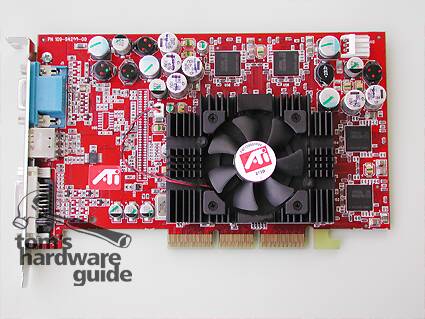AGP Platform Analysis, Part 1: New Cards, Old System
The New AGP Lineup, Continued
Radeon 9700 PRO
Online Price: N/A
Codename: R300, 150 nanometer technology
8-pipeline
256-bit memory bus
325 MHz core, 310 MHz DDR (620 MHz effective) memory
The Radeon 9700 PRO
For reference, we included one of the oldies but goodies: A Radeon 9700 PRO. This card represents the performance of other cards as well: the 9700 PRO will perform similarly to the Radeon 9800 PRO, Radeon X700, Radeon X1300 PRO, Geforce FX 5900, Geforce 6600 and Geforce 7300 GS.
Test System And Methodology
| System Hardware | |
|---|---|
| Processor(s) | AMD Athlon XP 2500+ (Barton)1.83 GHz, 166 FSB, 512 kB L2 cache |
| Platform | Asus A7N8X-Deluxe (Socket A)Nvidia Nforce2 Chipset, BIOS 1008 |
| RAM | PATRIOT EP1 x 1024 MB PC3500 (CL2.0-3-2-5) |
| Hard Drive | Western Digital WD1200JB120 GB, 7,200 RPM, 8 MB cache, UltraATA/100 |
| Networking | On-board 100 Mbit Ethernet |
| Graphics Cards | ATI Radeon 9700 PRO (AGP)128 MB DDR2Sapphire Radeon X1950 PRO (AGP)512 MB GDDR3Powercolor Radeon X1950 PRO (AGP)256 MB GDDR3Leadtek Geforce 7600 GT (AGP)256 MB GDDR3BFG Geforce 7800 GS (AGP)256 MB GDDR3 |
| Power Supply | Raidmax , ATX, 450 W |
| System Software & Drivers | |
| OS | Microsoft Windows XP Professional 5.10.2600, Service Pack 2 |
| DirectX Version | 9.0c (4.09.0000.0904) |
| Graphics Driver | ATI Catalyst 6.12, Nvidia Forceware 93.71 |
As mentioned, we're using a rather antiquated - though still quite capable - Athlon XP 2500+ for our first AGP testing article. The system has 1 GB of RAM running in single channel mode, and should be a relatively useful representation of an older system and what it can do. In fact, not only does this platform represent the Athlon XP line, but it probably does a pretty good job of representing a 2.5 GHz Pentium 4 platform as well.
The test methodology we're using in this review might be a little different than what you're used to. Since we want to demonstrate something applicable in the real world, instead of using a list of resolutions we tested every game at two resolution AND detail levels. First we set them to the highest detail level and resolution that the most powerful cards could handle, and then at the much lower detail level and resolution that the slowest card could handle. As a result we think we have some really relevant and focused benchmark results here. It's a little different from what we usually present, but we thought it would be worthwhile to explore this approach as it might turn out to better represent real-world situations.
Get Tom's Hardware's best news and in-depth reviews, straight to your inbox.
Current page: The New AGP Lineup, Continued
Prev Page The New AGP Lineup, Continued Next Page Gaming BenchmarksDon Woligroski was a former senior hardware editor for Tom's Hardware. He has covered a wide range of PC hardware topics, including CPUs, GPUs, system building, and emerging technologies.
